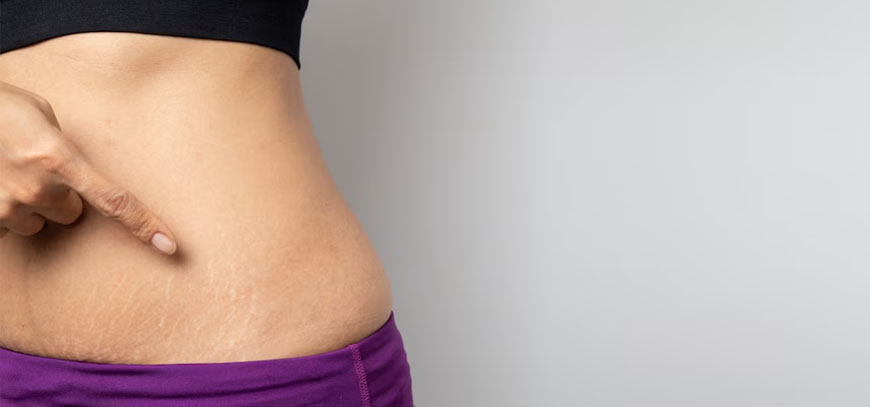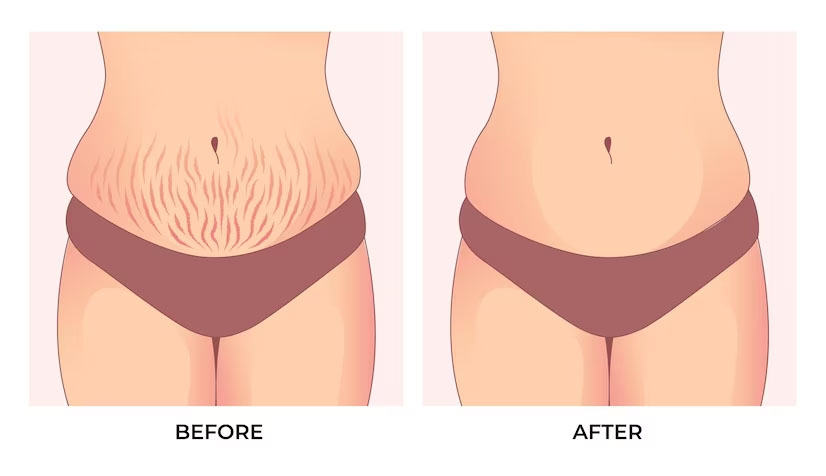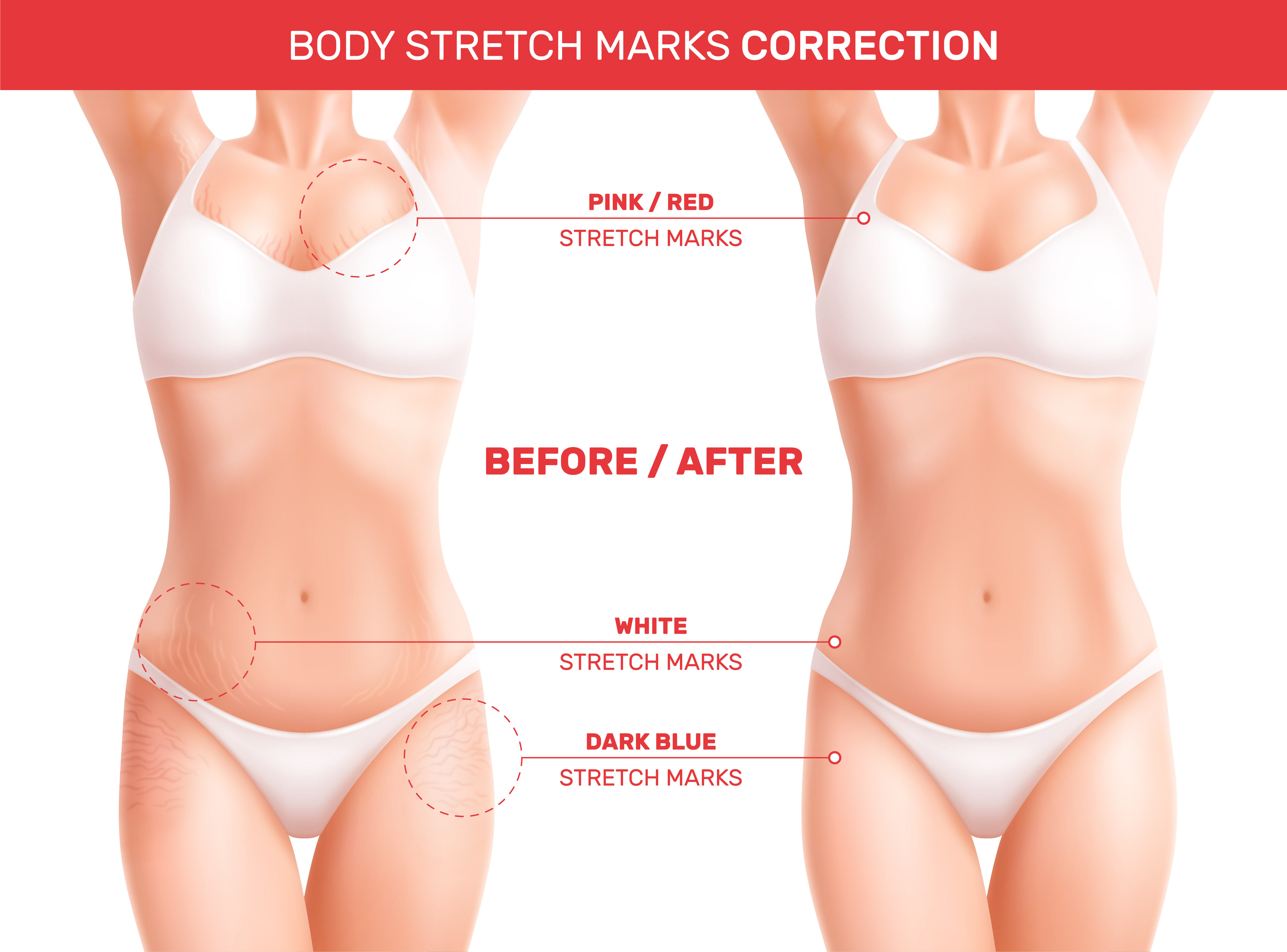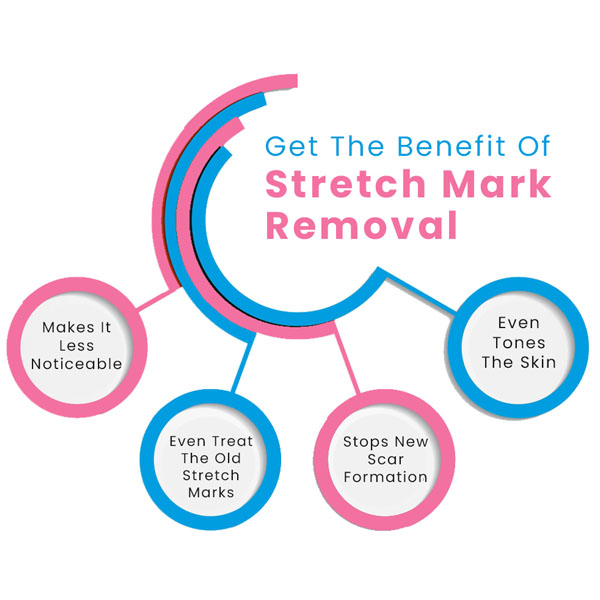Stretch Marks

Excessive and rapid skin stretching can lead to stretch marks. Surgical treatments and home remedies may help reduce their appearance, but results vary for each person. Surgical options include laser therapy, microdermabrasion, and chemical peels. Home remedies include using cocoa butter, shea butter, or coconut oil to moisturize the skin, along with regular massages and a balanced diet. Consulting a healthcare professional is advisable for personalized advice. Patience and consistency are key when dealing with stretch marks.
What are stretch marks?

Stretch marks are a result of skin connective tissue stretching, leading to the formation of lines or bands on the skin's surface. Over time, these marks fade to a white or silver color. Though not physically painful, severe cases can be disfiguring, impacting an individual's confidence and self-esteem.
The rapid stretching of the middle skin layer can cause some collagen fibers to break, allowing underlying blood vessels to become visible, resulting in red or purplish marks. As the blood vessels heal, the marks gradually change in color to the characteristic white or silver hue. While various treatments have been explored over the years, none have been proven to completely erase stretch marks.
However, there is hope, as new treatment methods are emerging and showing promise in addressing stretch marks. Even though complete eradication might not be possible, these advancements offer possibilities for reducing the appearance and improving the overall condition of stretch marks.
Treatments for Stretch Marks
Seeking help from skin doctors and plastic surgeons offers hope in reducing the appearance of stretch marks. While no universal solution exists, some stretch marks surgery has shown success for many individuals:
• Retin-A (Tretinoin):
Although evidence is limited, a cream containing 0.1 percent tretinoin has been found to diminish early stretch marks in some studies. Tretinoin, known by its brand name Retin-A, can stimulate collagen production by penetrating the skin's upper layer. It is available only with a prescription and is most effective on new stretch marks. Pregnant or nursing women should avoid using this drug due to potential side effects like redness and peeling.
• Laser or Light Therapy:
Proven methods for significantly improving stretch marks, laser and light therapy can be expensive but yield positive results. Pulsed dye lasers and intense pulsed light can enhance stretch mark appearance and stimulate collagen production over time. To ensure safety and effectiveness, these procedures should be performed by qualified plastic, cosmetic, or skin surgeons.

It's crucial to consult fully trained and licensed healthcare practitioners for these treatments. Depending on the severity of stretch marks, an individual may require up to 20 treatments to achieve a 20- to 60-percent improvement, making the overall cost a consideration. Early treatment is often more effective, as tretinoin and certain therapies may have limited benefits once the stretch marks have faded to white or silver.
• Dermapen Microneedling
Dermapen microneedling stands as a highly sought-after procedure for revitalizing the skin, addressing a diverse array of conditions. This technique, in contrast to injectable treatments, initiates a wholly natural process that triggers the body's intrinsic repair and renewal mechanisms, leading to collagen production. By skillfully adjusting micro-fine needles to various depths and speeds, fractional puncture channels are delicately created on the skin's surface. These minute channels facilitate the deep penetration of a selected meso-glide serum, tailored to rectify specific skin concerns, thereby heightening its efficacy and delivering revitalizing nutrients.
The heightened absorption of Meso-Glides, in conjunction with the innate enhancement of collagen and elastin, yields plumper, more youthful-looking skin. Dermapen microneedling, when applied to the face, effectively diminishes unwanted lines, wrinkles, and imperfections. Nonetheless, its versatility extends to multiple body regions. Notably, areas such as the hands, neck, and décolleté have gained popularity, yet any region craving a collagen boost for addressing thinning, sagging, sun-damaged, or problematic skin can be treated.
While a plethora of options exist in the market, both for salon and at-home microneedling, it's imperative to be discerning. Not all products are created equal, and some microneedling devices might potentially have adverse effects. When executed with precision and within a sterile environment, microneedling holds the potential for swift and impressive outcomes.
• Radio Frequency Skin Tightening
Radiofrequency (RF) therapy, also referred to as radiofrequency skin tightening, presents a noninvasive approach for enhancing skin tautness.
The procedure revolves around the utilization of energy waves to gently warm the underlying layer of the skin, known as the dermis. Through this controlled application of heat, the production of collagen is stimulated.
Collagen, a pivotal protein in the body, constructs the structural foundation of the skin, imparting its resilience and firmness.
As the years progress, collagen production diminishes, resulting in sagging skin and the emergence of wrinkles. The onset of skin laxity typically begins around the ages of 35 to 40, coinciding with a decline in both the quantity and quality of collagen.
With its inception dating back to 2001, RF therapy has emerged as a means to combat sagging skin and the manifestations of aging. In this discourse, we delve into the mechanics of this cosmetic procedure and explore the potential advantages it offers for skin rejuvenation.
• Microdermabrasion
Microdermabrasion emerges as a minimally invasive and increasingly popular approach in the realm of skin care. Its primary objective revolves around the restoration of skin's overall tone and texture, making it an appealing option for individuals seeking to address a range of skin imperfections. From the effects of sun exposure and the presence of wrinkles to the aftermath of acne, microdermabrasion has gained recognition for its potential to offer noticeable improvements.
In practice, this procedure involves the utilization of a specialized applicator designed with a surface featuring a gentle abrasive quality. Through controlled and precise movements, the applicator delicately exfoliates the outermost layer of the skin. By eliminating this superficial layer, which can accumulate dead skin cells and impurities, microdermabrasion unveils a fresher and smoother surface underneath. This renewal process contributes to an enhanced appearance, as the newly exposed skin reflects light more evenly and appears revitalized.
One of the notable advantages of microdermabrasion lies in its versatility. Whether someone is grappling with uneven skin tone, minor scars, or the desire to diminish the appearance of fine lines, this procedure can cater to various concerns. Its non-invasive nature further adds to its appeal, often making it a preferred choice for those seeking subtle yet noticeable skin rejuvenation. While individual results may vary, the consensus points toward microdermabrasion as an effective method to restore skin vitality and promote a refreshed complexion.
• Chemical Peels
Chemical peels represent a technique wherein a solution is applied to the facial skin, serving to eliminate deceased skin cells while stimulating the regeneration of fresh ones.
The core objective behind this procedure is to enhance the skin's appearance, often targeting issues such as age spots and uneven skin tone, ultimately fostering a more refined look.
Chemical peels come in three distinct categories: superficial, medium, and deep.
Superficial and medium peels typically demonstrate a favorable safety profile when administered accurately. These types of peels are temporary in nature, necessitating periodic repetition to sustain their effects.
In contrast, deeper peels entail a higher level of risk. Despite being longer-lasting and often not requiring repeated applications, their heightened efficacy is matched by an elevated level of caution that must be exercised.
Features and Benefits of Stretch Mark Surgery

- Swift and non-surgical treatment sessions, ensuring minimal disruption to your daily life.
- Enjoy little to no downtime, allowing you to resume your activities without extended recovery periods.
- Experience only mild discomfort during the treatment process, ensuring a more comfortable experience overall.
- Laser treatment is effective for all skin types, making it a versatile solution for addressing stretch marks on various skin tones.
How much does stretch mark removal surgery cost in India?
Stretch marks removal surgery cost in India can vary based on several factors. One common treatment option, fractional laser therapy for stretch mark removal, generally falls within the range of 5000 to 20,000 Indian rupees (INR) per session. However, it's essential to note that actual costs may differ depending on individual clinics, the severity of the stretch marks, the number of sessions required, and the expertise of the healthcare professional conducting the procedure. As a result, it's advisable for individuals seeking treatment to inquire about specific pricing from qualified healthcare providers to get a more accurate estimate.
Frequently Asked Questions:
Fractional laser therapy can be effective for various types of stretch marks, including both new and old ones. However, the results may vary depending on the age and severity of the stretch marks. It's best to consult with a qualified healthcare professional to determine the most appropriate treatment option for your specific case.
While fractional laser therapy is generally considered safe, some individuals may experience mild side effects such as redness, swelling, or temporary changes in skin pigmentation. These effects are usually temporary and subside within a few days. It is essential to follow post-treatment care instructions provided by the healthcare practitioner to minimize any potential side effects.
The number of sessions needed can vary based on individual factors, including the extent of stretch marks and skin type. While some people may notice improvement after just a few sessions, others may require more treatments to achieve the desired results. On average, patients may need around 3 to 6 sessions, with intervals of 4 to 6 weeks between each session.
While fractional laser therapy can significantly reduce the appearance of stretch marks, it may not completely remove them. The treatment aims to stimulate collagen production and improve skin texture, leading to a visible reduction in the stretch mark's appearance. However, complete eradication of stretch marks may not be achievable, and individual results may vary.
Yes, there are alternative treatments available for stretch mark removal, depending on individual preferences and circumstances. Some other options include microdermabrasion, chemical peels, and micro needling, which may also help improve the appearance of stretch marks. It's crucial to discuss these options with a qualified healthcare provider to determine the most suitable treatment plan for your specific needs.
Procedure Time:
- 30-45 minutes
Anesthesia:
- None
Recovery:
- No down time
Number of sessions:
- 4-6 session
Results:
• Seen in 1-2 sessions
Duration of results:
• Permanent improvement with 95% success rate
Risks & complications:
• Mild redness, itching or swelling
* Individual results and reactions may vary.
